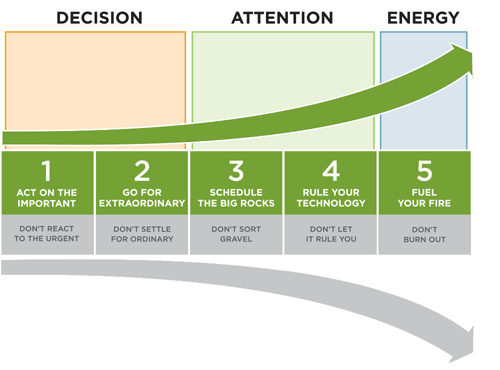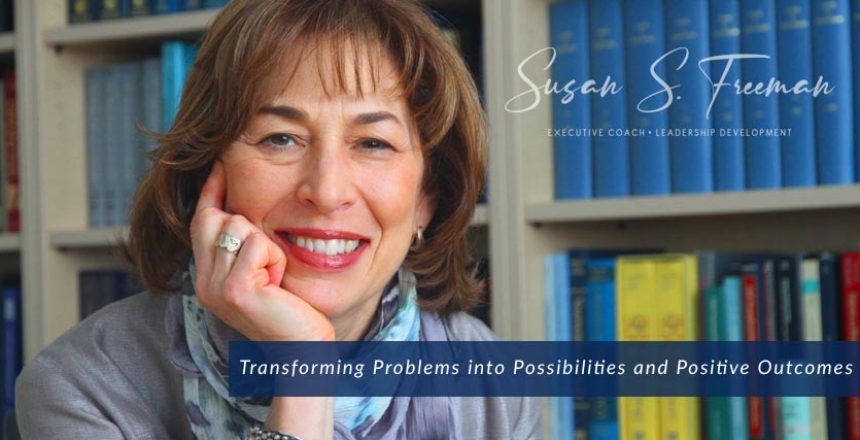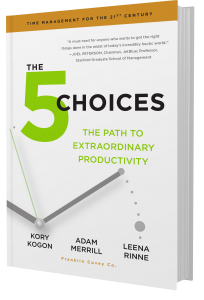This week’s “Step Up Leader Tips” borrows from Leading Blog. I chose this topic because it is one of the most frequently requested topics in my coaching sessions with leaders; increasing productivity without increasing hours worked. I would add that obtaining crystal clarity on vision, objective and goals precedes your ability to work with the 5 choices model effectively.
“The 5 Choices is a nuts and bolts solution to greater productivity.”
Ironically, while we live in a time of unprecedented opportunity, we spend almost half (40%) of our time attention and energy on unimportant or irrelevant activities almost insuring that we miss the possibilities all around us. Not only does that leave us feeling empty, but we end the day uncertain that we’ve accomplished what we needed to get done. We worry about things left undone and end up dreading the day ahead.
The authors, Kory Kogon, Adam Merrill, and Leena Rinne, say that the biggest hidden cost in our organizations is people spending their time, attention, and energy on things that don’t drive the most important results.
The 5 Choices
To improve the situation we have we have five choices to make in three areas:
- Decision Management
- Attention Management
- Energy Management.

The 5 Choices are:
Choice 1: Act on the Important, Don’t React to the Urgent
What is my return on this moment? This is really the foundational choice to make. “In today’s world, we can’t just go on the ‘I have a busy life’ autopilot and expect to end up where we want to be.” The authors have offered a Time Matrix model to help us make good decisions about where we spend our time, attention, and energy. Too often we get caught up in Quadrant 4 spending time (or too much time) on the trivial things that contribute nothing to our life.
 Q1: The Quadrant of Necessity. “These are things that need to be done now and, if not done, could have serious consequences.”
Q1: The Quadrant of Necessity. “These are things that need to be done now and, if not done, could have serious consequences.”
Q3: The Quadrant of Distraction. These are activities marked as urgent that feel like they need to be done now, but there are no serious consequences if you don’t do them. “Many people spend a lot of time in Q3 thinking they’re in Q1. However, they’re just reacting to everything coming their way. They are confusing motion with progress, action with accomplishment.”
Q4: The Quadrant of Waste. These are activities that are neither urgent nor important. When we get burned out we often go here for escape. “When we spend a lot of time in Q4, we feel lethargic and aimless. If we stay too long, we can experience depression and even despair.”
Q2: The Quadrant of Extraordinary Productivity. These are that activities that will make a real difference in terms of accomplishment and results like proactive work, achieving high-impact goals, creative thinking, planning, prevention, relationship building, learning, and renewal. But you have to make a conscious choice to operate in this quadrant.
Choice 2: Go for Extraordinary, Don’t Settle for Ordinary
Most people don’t clarify what is important to them so they never spend the time working on those things. Identify your roles. “Roles are where life happens. It’s where we build relationships, where all the activities that make us human go on.” Craft a role statement for each role.
Choice 3: Schedule the Big Rock, Don’t Sort Gravel
“In today’s environment, the key to true productivity is not to get more things done, but to get the right things done—the important things—with the highest quality you can achieve. It’s not about doing more with less, but doing more about less.” Plan and decide when.
Choice 4: Rule Your Technology, Don’t let it Rule You
There are basically four types of information you need to manage: Appointments (Things you need to do at specific times), Tasks (Things you need to do that are not yet scheduled), Contacts (Information about people you interact with), and Notes or Documents (Other information you want to keep track of that does not fall into one of the other three categories). Organize accordingly.
Choice 5: Fuel Your Fire, Don’t Burn Out
Constant stress, poor diet, lack of exercise and sleep lead to burnout. The five energy drivers are adequate movement, proper diet, sleep, relaxation, and positive social connections. Your brain is your number-one asset in a knowledge-work world. Fuel it properly.”
I’ve discovered that leaders who are open to learning benefit immensely from foundational support and accountability for the 5 choices. If this resonates with you, I invite you to Passion, Clarity, and Exceptional Results by visiting susansfreeman.com/services.


